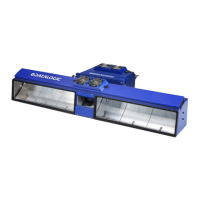COMMUNICATIONS
PRODUCT REFERENCE GUIDE
181
Enable Client
Click the check-box to enable the device as a client
Protocol
Select one of the following from the drop-down. Specific Protocol Index Settings will display
based on your selection.
•Disable
•Standard
•Advanced
•Crisplant
•Beumer
•Custom 1-5
•Web Sentinel
•Video Coding (PV v2.4)
•SC5000
•Trigger Message
Ethernet /IP Object Selection
Click the drop-down to select ASI Object. Currently it is the only object available.
Enable ControlLogix On-Demand
Click the check-box to enable ControlLogix On-Demand. If selected, the following three On-
Demand Options are revealed.
PLC IP Address
Enter the IP address of the PLC.
Tag Name
Enter the Name of the Tag that contains the bar code data.
PLC Slot Number
Enter the slot number of the PLC.
Message Options
Message Format
Select ASCII or Binary from the drop-down list.
•
ASCII - Select to transmit an ASCII barcode message (as defined by the Message Type). The
only difference is that the Header and Trailer are omitted from the barcode messages
transmitted using EtherNet/IP. When ASCII messages are in use, the Byte Swap ASCII Data
selection will swap the high and low byte of data within each 16 bit word. This is useful for
processing data on some Programmable Controllers.
•
Binary - Select to convert barcode data to a “numeric value” and transferred as a 32 bit
word. The user can specify the byte ordering of this word. If any non-numeric (not ASCII ‘0’ to
‘9’ or leading or trailing space) characters are contained in the barcode, the numeric value is
zero.
ASCII Message Byte Swap
Select the check box to enable the function. Available when Binary is selected from the
Message Format drop-down list. When ASCII messages are in use, the ASCII Message Byte
Swap selection will swap the high and low byte of data within each 16 bit word. This is useful
for processing data on some Programmable Controllers.
Binary Message Byte Order
If you have selected a Binary Message Format, you will need to click this drop-down and select
the Little Endian or Bif Endian for the correct Byte Order.
•Little Endian: little-endian system stores the least-significant byte at the smallest address.
•Big Endian: big-endian system stores the most significant byte of a word at the smallest
memory address and the least significant byte at the largest.

